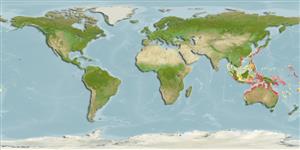分类 / Names
俗名 | 同种异名 | Catalog of Fishes(属, 种) | ITIS | CoL | WoRMS | Cloffa
Teleostei >
Eupercaria/misc (Various families in series Eupercaria)
鱸形目 (Various families in series Eupercaria) >
Labridae (Wrasses)
隆頭魚科 (Wrasses) > Bodianinae
Etymology: Choerodon: Greek, choiros = a pig + odous = teeth (Ref. 45335); referrring to the prominent anterior canines of the species in this genus (Ref. 116605).
More on author: Richardson.
Environment: milieu / climate zone / depth range / distribution range
生态学
海洋 礁区鱼类. 亞熱帶的
Indo-West Pacific: Western Australia to Queensland. Reported to range from Sri Lanka to Papua New Guinea, north to the Ryukyu Islands, south to New Caledonia (Ref. 9710).
印度-西太平洋: 澳洲西部到昆士蘭省。 報告範圍從斯里蘭卡到巴布亞新幾內亞, 北至琉球群島, 南至新加勒多尼亞.(參考文獻 9710)
大小 / 重量 / 年龄
Maturity: Lm ? range ? - ? cm
Max length : 70.0 cm TL 雄鱼/尚未辨别雌雄; (Ref. 2334)
背棘 (总数): 13; 背的软条 (总数): 7; 臀棘 3; 臀鳍软条: 10. Body with about 5 very faint broad dusky bands dorsally on side in most freshly preserved specimens. A large pale spot often present below posterior end of caudal fin in adults. No darky spot present on side below fifth or sixth dorsal-fin spine. Adults with second prominent anterior canine approximately same size as first, second canine slanted dorsally. (Ref 9823)
身体有大约 5条非常模糊的宽暗色的条纹在侧边背面上在最新保存的标本。 一个大的灰白斑点时常在尾鳍的后端之下呈现当成鱼时。 没有黑的斑点在第五的或第六根背鳍棘之下位于侧边之上。 成鱼有第二的突出前面的犬齿第一个大约与大小相同, 第二个犬齿背面倾斜的。 (参考文献 9823)
Adults inhabit sand and rubble areas of reef flats and flat shelf bottoms of outer reef slopes (Ref. 9710). They enter very shallow water, and feed mainly on mollusks. Oviparous, distinct pairing during breeding (Ref. 205).
栖息于礁石平台与外礁斜坡的平坦大陆架底部的沙子与碎石区。 (参考文献 9710) 进入很浅的水域,它主要捕食软件动物。
Life cycle and mating behavior
成熟度 | 繁殖 | 产卵场 | 卵 | 孕卵数 | 仔鱼
Oviparous, distinct pairing during breeding (Ref. 205).印度-西太平洋: 澳洲西部到昆士蘭省。 報告範圍從斯里蘭卡到巴布亞新幾內亞, 北至琉球群島, 南至新加勒多尼亞.(參考文獻 9710)
Randall, J.E., G.R. Allen and R.C. Steene, 1990. Fishes of the Great Barrier Reef and Coral Sea. University of Hawaii Press, Honolulu, Hawaii. 506 p. (Ref. 2334)
人类利用
水族馆: 商业性
更多信息
参考文献养殖养殖信息品种遗传学Electrophoreses遗传率疾病加工NutrientsMass conversion
合作者照片Stamps, Coins Misc.声音神经毒速度泳型鳃区Otoliths脑重体重比眼睛色素
工具
特别资料
下载 XML
网络资源
Estimates based on models
Preferred temperature (Ref.
123201): 24.6 - 29.3, mean 28.4 °C (based on 1845 cells).
Phylogenetic diversity index (Ref.
82804): PD
50 = 0.5000 [Uniqueness, from 0.5 = low to 2.0 = high].
Bayesian length-weight: a=0.01318 (0.00582 - 0.02984), b=3.05 (2.86 - 3.24), in cm total length, based on LWR estimates for this (Sub)family-body shape (Ref.
93245).
营养阶层 (Ref.
69278): 3.6 ±0.50 se; based on food items.
回复力 (Ref.
120179): 低的, 最小族群倍增时间4.5 - 14 年 (Preliminary K or Fecundity.).
Fishing Vulnerability (Ref.
59153): Moderate to high vulnerability (48 of 100).
Nutrients (Ref.
124155): Calcium = 19.6 [9.5, 38.6] mg/100g; Iron = 0.484 [0.269, 0.903] mg/100g; Protein = 19.4 [16.5, 21.6] %; Omega3 = 0.19 [0.11, 0.33] g/100g; Selenium = 17.3 [8.7, 33.0] μg/100g; VitaminA = 47.5 [14.6, 188.4] μg/100g; Zinc = 0.759 [0.516, 1.245] mg/100g (wet weight);
